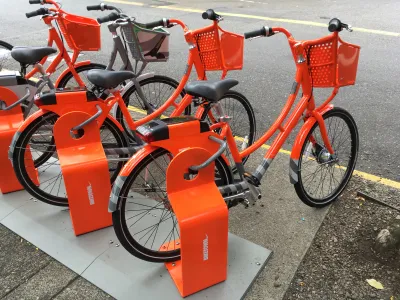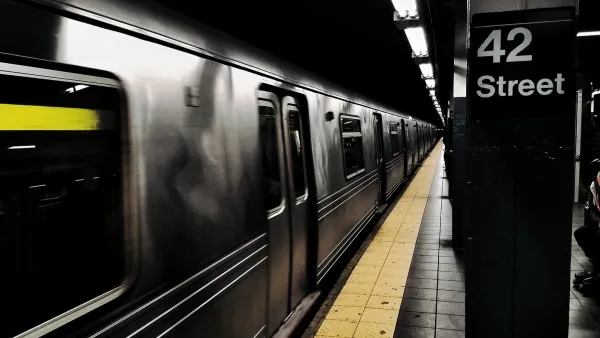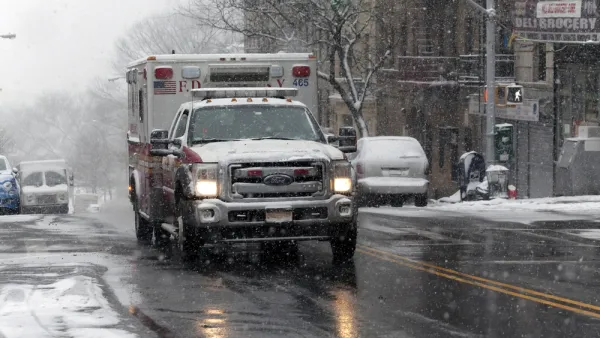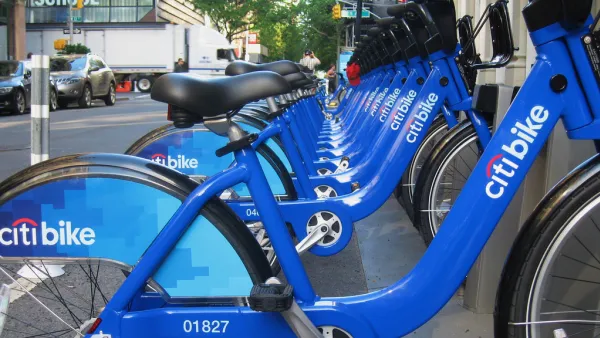Bikeshare programs were first introduced in the U.S. seven years ago. Outside Magazine investigates whether they "are actually benefiting cities and their residents."

"What metrics should we use to determine whether the concept itself is a success?" asks Joe Lindsey.
A good place to start is to look at the three major factors that Zoe Kircos, director of grants and partnerships for advocacy group People for Bikes, says are the primary goals of bike sharing: reducing traffic congestion, boosting public health, and increasing mobility.
Lindsey cites three studies that provide some answers:
- [A] 2014 report from the NYC Department of Transportation found that even though some traffic lanes were converted to protected bike lanes on various streets, travel times for car traffic remained steady or improved: on Eighth Avenue, they were 14 percent faster, for example.
- A 2015 study in Transport Reviews looked at systems in five cities, including Washington, D.C., and Minneapolis, and found that users substituted rides via bike shares for car trips 8 percent of the time in D.C. and almost 20 percent of the time in Minneapolis.
- A separate study on D.C.’s Capital Bikeshare found that it contributed a modest but noticeable 2 to 3 percent reduction in traffic congestion.
The last two studies was undertaken about a year before the onset of the SafeTrack repair program, which reduced operating hours of the D.C. Metro. "The number of trips since the beginning of SafeTrack in June increased about 7 percent compared with June to November 2015," reports Planetizen's Casey Brazeal on November 28.
"One-day and single-trip fares are also up about 58 percent compared to pre-SafeTrack numbers," Luz Lazo [in the Washington Post] tells us.
Safety and Public Health
Lindsey also looks into the public safety and health aspect of the programs, citing two studies that show that while biking as a whole may be seeing increasing fatalities in the U.S., that's not the case for bikeshare:
- [A] recent study of New York’s Citi Bike program in BMJ’s journal Injury Prevention found that the city’s addition of bike lanes, crucial to Citi Bike’s success, increased lifespan even among nonusers because of the reduction in pollution.
- [A] report on London’s massive bike-share system found injury rates for bike-share users were lower than those for regular cyclists.
- In the U.S., there has been one bike-share rider death in the system’s seven-year history. By contrast, roughly 700 cyclists die each year on America’s roads.
An April post looks into why bikeshare cycling has a better track record than regular cycling, notwithstanding the lack of helmet availability.
Subsidies
Lindsey also looks at one of bikeshare's criticisms: public funding. For the three different operating models (which he delineates), the public subsidy varies from small to none, as opposed to the huge subsidies that many public transit receives per ride, making many of the criticisms moot.
Not only are bike shares achieving statistically measurable improvements in traffic congestion and public health, they’re doing so at negligible cost to taxpayers.
Deficiencies
Another criticism is that bike share doesn't serve a diverse population, particularly minorities, low-income communities, and even women, despite the availability of discounted membership in some programs. Ford GoBike has announced a $5 discounted annual membership to attract low-income users to its Bay Area program when it launches in the Spring, though it only applies for the first year.
And not all bike shares have been financially successful, resulting in their discontinuance.
These failures have allowed developers to realize that bike-share programs work best at “scale and density,” according to Kate Fillin-Yeh, who helped launch Citi Bike and now directs the bike-share program at the National Association of City Transportation Officials (NACTO).
"So, is the concept of bike share as a whole a success?" asks Lindsey.
Despite some imperfections, there are very few arguments from users, researchers, or advocates that a bike-share system is bad for a city. But to better quantify the role it plays in the United States, we simply need more frequent and rigorous data and analysis, like the London study.
Hat tip to Melanie Curry of Streetsblog California.
FULL STORY: Do Bike Share Systems Actually Work?

Analysis: Cybertruck Fatality Rate Far Exceeds That of Ford Pinto
The Tesla Cybertruck was recalled seven times last year.

National Parks Layoffs Will Cause Communities to Lose Billions
Thousands of essential park workers were laid off this week, just before the busy spring break season.

Retro-silient?: America’s First “Eco-burb,” The Woodlands Turns 50
A master-planned community north of Houston offers lessons on green infrastructure and resilient design, but falls short of its founder’s lofty affordability and walkability goals.

Test News Post 1
This is a summary

Analysis: Cybertruck Fatality Rate Far Exceeds That of Ford Pinto
The Tesla Cybertruck was recalled seven times last year.

Test News Headline 46
Test for the image on the front page.
Urban Design for Planners 1: Software Tools
This six-course series explores essential urban design concepts using open source software and equips planners with the tools they need to participate fully in the urban design process.
Planning for Universal Design
Learn the tools for implementing Universal Design in planning regulations.
EMC Planning Group, Inc.
Planetizen
Planetizen
Mpact (formerly Rail~Volution)
Great Falls Development Authority, Inc.
HUDs Office of Policy Development and Research
NYU Wagner Graduate School of Public Service




























